Prevention of rabies in humans. Comprehensive Guide to Rabies Prevention: Protecting Humans and Animals
What is rabies and how is it transmitted. How can you recognize symptoms of rabies in animals. What steps should you take if exposed to a potentially rabid animal. How can you prevent rabies in pets and wildlife. What are the proper procedures for handling bats in your home.
Understanding Rabies: A Deadly Zoonotic Disease
Rabies is a severe viral infection that poses a significant threat to both humans and animals. This fatal disease targets the central nervous system, leading to devastating neurological effects. But what exactly is rabies, and how does it spread?
Rabies is caused by a virus that attacks the central nervous system, resulting in convulsions, paralysis, and ultimately death. The virus is primarily transmitted through the saliva of infected animals, most commonly through bites. In rare cases, transmission can occur through contamination of open wounds, fresh abrasions, or mucous membranes.
While all warm-blooded animals are susceptible to rabies, certain species are more frequently affected. These include:

- Wildlife: raccoons, skunks, foxes, and bats
- Domestic animals: dogs and cats (if unvaccinated)
It’s important to note that rabies is rarely seen in rodents such as mice, rats, squirrels, chipmunks, guinea pigs, and hamsters. Additionally, rabbits, birds, turtles, lizards, fish, and insects do not contract rabies.
Recognizing the Signs: Symptoms of Rabies in Animals
Identifying potential rabies cases in animals is crucial for prevention. How can you recognize a rabid animal? The most notable indicators are marked changes in an animal’s behavior. A rabid animal may exhibit the following symptoms:
- Unnatural withdrawal or isolation
- Unusual friendliness or calmness
- Extreme docility
- Aggressive behavior, snapping at anything in its path
- Appearing during daytime (for nocturnal animals)
- Seeking an isolated place to die
Understanding these symptoms can help you stay vigilant and take appropriate action if you encounter a potentially rabid animal.
The Importance of Prompt Treatment: Is There a Cure for Rabies?
When it comes to rabies, time is of the essence. Can rabies be cured once symptoms appear? Unfortunately, once clinical signs of rabies manifest, the disease is almost always fatal. However, there’s hope in prevention.

Rabies can be prevented if early treatment is administered promptly after exposure. If you suspect contact with a potentially rabid animal, it’s crucial to seek immediate medical attention. The recommended treatment protocol includes:
- An initial dose of rabies vaccine
- A protective injection
- Four additional doses of vaccine administered over 28 days
This post-exposure prophylaxis (PEP) is highly effective when administered promptly, highlighting the importance of seeking medical care without delay after a potential rabies exposure.
Protecting Your Pets: Rabies Prevention for Dogs and Cats
As responsible pet owners, it’s our duty to protect our furry companions from rabies. How can you safeguard your pets against this deadly disease? Here are some essential steps:
- Vaccinate your dogs and cats against rabies as required by law. All dogs and cats over four months of age must be vaccinated.
- Keep vaccinations current at all times.
- Maintain control over your pets. Animal control laws prohibit allowing animals to roam unsupervised.
- Keep your pets away from stray or unknown animals, as they are more likely to have been exposed to rabies.
By following these guidelines, you not only protect your pets but also contribute to the overall prevention of rabies in your community.

Wildlife Safety: Minimizing Rabies Risks from Wild Animals
While wildlife plays a crucial role in our ecosystems, it’s important to maintain a safe distance to prevent rabies transmission. How can you minimize risks associated with wild animals?
- Leave wild animals alone, even if they appear friendly.
- Do not attempt to feed wild animals by hand.
- Teach children to respect and stay away from wildlife.
- Avoid keeping wild animals as pets. Even captive-born animals may carry rabies, and local laws often prohibit keeping wildlife as pets.
- Make your property unattractive to wild animals by capping chimneys, sealing openings in attics, under porches, and in basements.
- Feed pets indoors and keep trash cans tightly closed to avoid attracting wildlife.
By respecting wildlife and maintaining appropriate boundaries, we can coexist safely while minimizing the risk of rabies transmission.
Emergency Protocol: What to Do If Bitten or Scratched by an Animal
In the event of an animal bite or scratch, quick and appropriate action is crucial. What steps should you take if you’re bitten, scratched, or come into contact with a potentially rabid animal?

- If possible, obtain the owner’s contact information for the animal.
- Immediately wash the wound thoroughly with plenty of soap and water for several minutes.
- Report the incident to your local animal control agency, police department, or health department for follow-up.
- If the animal is wild or stray, try to identify and observe it from a safe distance to aid in its eventual capture.
- Seek prompt medical attention by contacting your doctor or visiting the nearest emergency room.
Remember, early intervention is key in preventing rabies. Don’t hesitate to seek professional help, even if the wound seems minor.
Protecting Your Pets After an Encounter
If your pet has been bitten, scratched, or had contact with a wild animal, follow these steps:
- Call your pet away from the wild animal.
- If possible, confine the wild animal without risking your own exposure.
- Avoid handling your pet for at least two hours after the incident to prevent potential exposure to saliva.
- If you must handle your pet, wear heavy gloves and wash your hands thoroughly afterward.
- Contact your local animal control agency for advice on testing the wild animal and follow-up care for your pet.
By following these guidelines, you can protect both yourself and your pet in the aftermath of a potentially dangerous encounter.

Bat Encounters: Proper Handling and Rabies Prevention
Bats are known carriers of rabies, and encounters with these creatures require special attention. What should you do if you find a bat in your house?
- Contact animal control for assistance.
- Close windows and closet doors to contain the bat.
- Turn on all lights if the room is dark.
- Leave the room and close the door behind you.
- Do not release the bat.
Any bat that may have had contact with a person should be tested for rabies. If the bat cannot be found or has escaped, contact the Animal Disease Prevention Division of the Department of Health and consult a doctor as soon as possible.
The Importance of Bat Testing
Why is it crucial to test bats for rabies? Bat bites can be small and easily overlooked, making it difficult to determine if exposure has occurred. Testing the bat allows health professionals to make informed decisions about necessary medical treatment. The Department of Health will notify you of the test results, enabling you and your doctor to decide on the appropriate course of action.

Global Efforts in Rabies Prevention and Control
Rabies prevention is not just a local concern but a global health priority. How are international organizations addressing this deadly disease?
The World Health Organization (WHO), in collaboration with the Food and Agriculture Organization of the United Nations (FAO) and the World Organisation for Animal Health (OIE), has set a goal to eliminate dog-mediated human rabies deaths by 2030. This initiative, known as “Zero by 30,” focuses on several key areas:
- Mass dog vaccination campaigns
- Improved access to post-exposure prophylaxis for humans
- Enhanced surveillance and data collection
- Public education and awareness programs
These global efforts demonstrate the importance of a One Health approach, recognizing the interconnectedness of human, animal, and environmental health in addressing zoonotic diseases like rabies.
Innovative Approaches to Rabies Prevention
Research and innovation continue to play a crucial role in rabies prevention. Some promising developments include:

- Oral rabies vaccines for wildlife: Baits containing rabies vaccines are distributed in areas with high wildlife rabies prevalence.
- Improved diagnostic techniques: Rapid and accurate diagnostic tests are being developed to facilitate quicker treatment decisions.
- Novel vaccine delivery methods: Research is ongoing into alternative vaccine administration routes, such as intradermal delivery, which could reduce the cost and improve the accessibility of post-exposure prophylaxis.
These advancements offer hope for more effective rabies control and prevention strategies in the future.
Education and Awareness: Key Components of Rabies Prevention
Public education plays a vital role in rabies prevention. How can communities enhance awareness and promote responsible practices?
- School programs: Implementing rabies education in school curricula can help children understand the importance of animal safety and rabies prevention from an early age.
- Community outreach: Local health departments can organize workshops, seminars, and information sessions to educate the public about rabies risks and prevention strategies.
- Media campaigns: Utilizing various media platforms to disseminate accurate information about rabies can reach a wider audience and dispel myths surrounding the disease.
- Collaboration with veterinary clinics: Partnering with local veterinarians to promote pet vaccination and responsible pet ownership can significantly reduce rabies risks in domestic animals.
By fostering a well-informed community, we can create a strong foundation for effective rabies prevention and control.

The Role of Healthcare Professionals in Rabies Prevention
Healthcare providers play a crucial role in rabies prevention and management. Their responsibilities include:
- Assessing potential rabies exposures
- Administering post-exposure prophylaxis when necessary
- Providing accurate information to patients about rabies risks and prevention
- Collaborating with local health departments and animal control agencies
- Staying updated on the latest rabies prevention guidelines and treatment protocols
Continuous education and training for healthcare professionals ensure that they can effectively contribute to rabies prevention efforts in their communities.
Economic Impact of Rabies: The Cost of Prevention vs. Treatment
Rabies not only poses a significant health risk but also carries substantial economic implications. How does the cost of rabies prevention compare to the cost of treatment?
Prevention strategies, such as pet vaccination programs and public education initiatives, are generally more cost-effective than treating human rabies cases. The cost of post-exposure prophylaxis can be significant, especially in developing countries where access to healthcare may be limited.
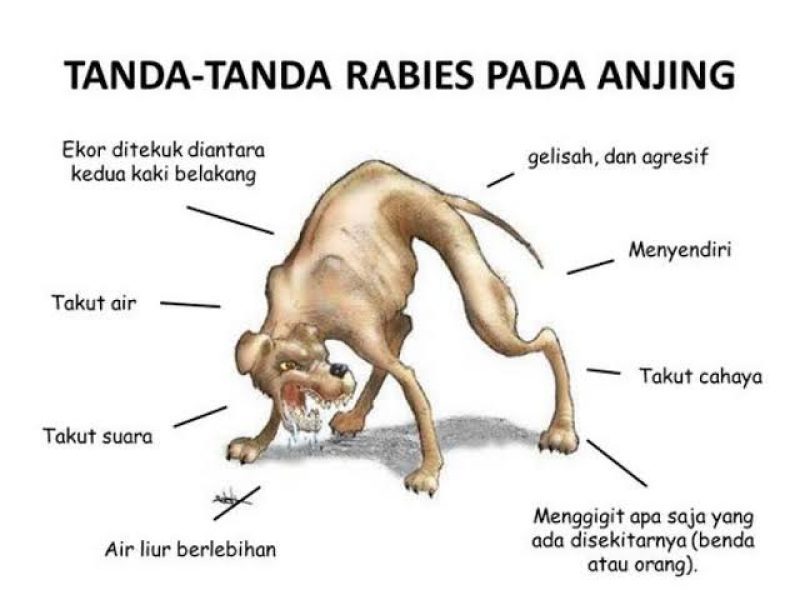
Investing in comprehensive rabies prevention programs can lead to long-term economic benefits by:
- Reducing healthcare costs associated with human rabies cases
- Minimizing productivity losses due to illness or death from rabies
- Decreasing the burden on healthcare systems and animal control agencies
- Potentially boosting tourism in areas where rabies is effectively controlled
By prioritizing prevention, communities can not only save lives but also allocate resources more efficiently in the long run.
The Challenge of Rabies in Developing Countries
While rabies is well-controlled in many developed nations, it remains a significant challenge in developing countries. Factors contributing to this disparity include:
- Limited access to veterinary care and pet vaccination programs
- Large populations of stray dogs
- Insufficient public health infrastructure
- Lack of awareness about rabies risks and prevention strategies
- Financial constraints in implementing comprehensive rabies control programs
Addressing these challenges requires a multifaceted approach, including international cooperation, resource allocation, and capacity building in affected regions.

The Future of Rabies Prevention: Emerging Technologies and Strategies
As we look to the future, what new technologies and strategies might shape rabies prevention efforts? Several promising developments are on the horizon:
- Gene editing: CRISPR technology could potentially be used to develop more effective vaccines or even create rabies-resistant animal populations.
- Artificial intelligence: Machine learning algorithms could enhance surveillance systems, predicting rabies outbreaks and optimizing resource allocation.
- Drone technology: Unmanned aerial vehicles could be used to distribute oral vaccines in hard-to-reach areas, improving wildlife vaccination efforts.
- Mobile health applications: Smartphone apps could provide real-time information about rabies risks, vaccination clinics, and post-exposure protocols.
- One Health information systems: Integrated databases combining human, animal, and environmental health data could improve rabies surveillance and control strategies.
These innovative approaches hold the potential to revolutionize rabies prevention and bring us closer to the goal of eliminating human rabies deaths worldwide.
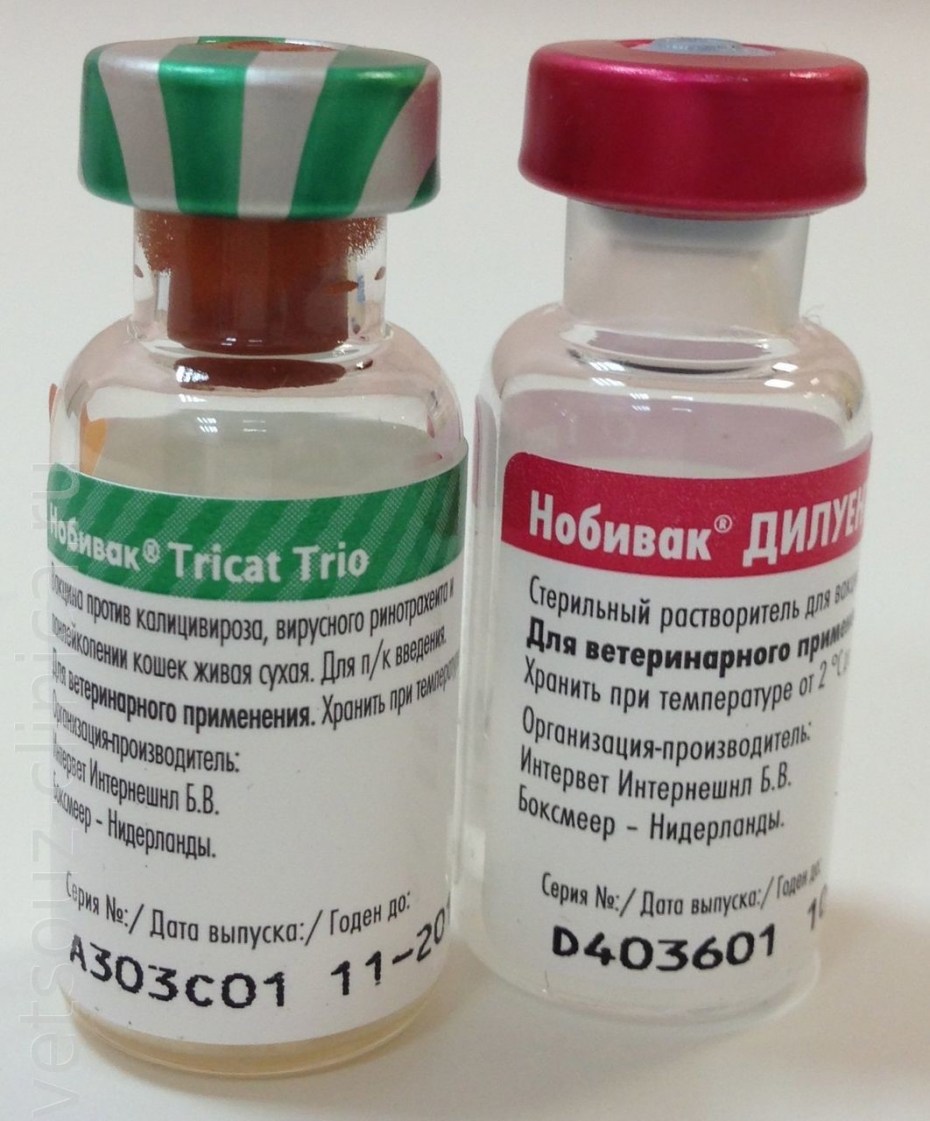
The Importance of Continued Research
Ongoing research remains crucial in the fight against rabies. Key areas of focus include:
- Development of more effective and affordable vaccines
- Improved understanding of rabies virus transmission and pathogenesis
- Exploration of novel treatment options for clinical rabies cases
- Investigation of factors influencing rabies virus adaptation to new host species
- Assessment of the potential impact of climate change on rabies distribution and prevalence
By supporting and investing in rabies research, we can continue to make strides in prevention, control, and ultimately, elimination of this deadly disease.
Rabies Prevention | doh
Listen
Rabies is a fatal disease transmitted from animals to humans, caused by a virus that attacks the central nervous system, causing convulsions, paralysis and finally death. The virus is present in the saliva of a rabid animal and is transmitted primarily by animal bites and rarely by contamination of open wounds, fresh abrasions or mucous membranes.
All warm-blooded animals can be affected by the virus, but it is most often found in wildlife such as raccoons, skunks, foxes, and bats. Dogs and cats may also contract rabies if they are not vaccinated against it.
Rabies is rarely seen in rodents such as mice, rats, squirrels, chipmunks, guinea pigs, hamsters, or in rabbits. Birds, turtles, lizards, fish, and insects do not contract rabies.
Symptoms of Animal Rabies
Marked changes in an animal’s behavior are symptoms of rabies. A rabid animal may:
- Be unnaturally withdrawn
- Be unusually friendly or calm
- Be very docile
- Snap at anything in its path
- Appear in the daytime (if it’s nocturnal)
- Search for an isolated place to die.

Is There a Cure for Rabies?
Once signs of rabies appear, the disease is almost always fatal. However, rabies can be prevented if early treatment is administered. If in contact with an animal with possible rabies, you must contact the health department or a medical facility for advice on rabies prevention treatment.
Treatment includes a first dose of vaccine and another protective injection. Then 4 more doses of vaccine are administered over 28 days.
Tips to Prevent Rabies
- Vaccinate dogs and cats against rabies as required by law. All dogs and cats more than four months of age must be vaccinated against rabies. Keep vaccinations current at all times.
- Keep dogs and cats under control. Animal control laws prohibit allowing animals to roam unsupervised. Roaming pets are more likely to have been exposed to rabies than those supervised by their owners.
- Leave stray or unknown dogs and cats alone. Loose animals are more likely to have been exposed to rabies and to attack others.
 Keep pets away from strays, too.
Keep pets away from strays, too. - Leave wild animals alone. Avoid wild animals even if they appear friendly, and do not coax a wild animal to eat from your hand. Do not fear wild animals, just respect and stay away from them. Very young children can learn this rule.
- Do not keep wild animals as pets. Even a raccoon or skunk born in captivity may be a rabies carrier. Local laws prohibit acquiring of keeping such animals as pets. There are no approved vaccines or known quarantine for wild animals.
- Make your property unattractive to wild animals. Cap chimneys and seal off any openings in attics, under porches and in basements. Feed your pets indoors and keep trash cans tightly closed.
If YOU are Bitten, Scratched, or have Contact with an Animal:
- Obtain the owner’s address and telephone number if possible.
- Immediately wash the wound thoroughly, cleaning and flushing with plenty of soap and water for several minutes.
- Immediately report all animal bites to your animal control agency, police department of health department for follow-up.

- Identify and continue to observe the animal (if wild or stray) to aid its eventual capture, but do not risk exposure again.
- Get prompt medical attention. Call your family doctor or go to the nearest emergency room.
If Pets are Bitten, Scratched, or have Contact with a Wild Animal:
- Call your pet away from the animal.
- Confine the wild animal, if possible. (Do not touch it or risk exposing yourself.)
- To prevent exposure of saliva to an open wound, it is recommended that you do not handle pets, touch or examine your dog or cat for at least two hours following the fight.
- If you must handle your pet shortly after a fight, wear heavy gloves and afterwards be sure to thoroughly wash your hands with soap and water. Then contact your doctor or local health department for advice to determine whether or not there may have been any direct exposure to the rabies.
- Contact your local animal control agency immediately for advice about testing the wild animal for rabies and follow-up for your pet.

What if I have a bat in my house?
- Contact animal control for assistance.
- Close windows and closet doors.
- Turn on all the lights if the room is dark.
- Leave the room and close the door behind you.
- Do not release the bat.
Any live or dead bat that may have had contact with a person should be tested for rabies. When the rabies test results are known, the Department of Health will notify you so you and your doctor can make an informed decision regarding necessary medical treatment. If the bat cannot be found, or has escaped, contact the Animal Disease Prevention Division of the Department of Health, and see a doctor as soon as possible.
For more information, visit The Centers for Disease Control (CDC).
Rabies in the District of Columbia
Each year, the Animal Disease Prevention Division tests hundreds of wild and domestic animals. Most of the results are negative for the disease. Select from the links below for Rabies data.
- Animals that Tested Positive for Rabies Since 1982
- Rabies Incidence in the District of Columbia for 2013 [PDF]
- A Map of Animal Rabies Cases for 2013 [PDF]
Related Services:
Rabies and Animal Exposures
Contact Phone:
(877) 672-2174
Contact Fax:
(202) 727-8471
Contact TTY:
Office Hours:
Monday to Friday 8:15 am to 4:45 pm
Service Location:
Symptoms, causes, vaccine, treatment, and prevention
Rabies is a dangerous virus that causes brain inflammation. Animals can spread rabies to humans through bites and scratches. The rabies vaccines and other medications can treat infections.
Without treatment, the disease can be fatal. However, it is treatable if a person who has had exposure to rabies seeks immediate medical attention.
In the United States, between 1 and 3 people contract rabies each year. From 2008 to 2019, the U.S. saw 25 human cases of the disease, with eight involving people contracting rabies outside the country. Since the 1970s, advances in medicine, awareness, and vaccination programs have reduced the incidence of rabies.
Since the 1970s, advances in medicine, awareness, and vaccination programs have reduced the incidence of rabies.
However, the disease remains a problem worldwide and causes tens of thousands of deaths annually, mostly in rural areas of Southeast Asia and Africa. Of all infections involving rabies, 99% occur due to dog bites.
Here are some facts about rabies:
- Rabies is a viral disease that nearly always occurs due to transmission by an animal bite carrying the infection.
- Anyone who receives a bite in a geographical area where rabies occurs should seek immediate treatment.
- For treatment to succeed, it must take place before symptoms appear.
- Symptoms include neurological problems and a fear of light and water.
- Following the vaccination requirements for pets helps prevent and control rabies.
Was this helpful?
Share on PinterestAggressive behavior of a caged canine, suspected of being rabid, 1980. Smith Collection/Gado/Getty Images
Rabies is a viral infection that primarily spreads through a bite from an infected animal. Without early treatment, it is usually fatal.
Without early treatment, it is usually fatal.
It is an RNA virus of the rhabdovirus family that can affect the body in one of two ways. It can enter the peripheral nervous system directly and migrate to the brain. It can also replicate within muscle tissue, where it is safe from the host’s immune system. From here, it enters the nervous system through the neuromuscular junctions.
Once inside the nervous system, the virus produces acute inflammation of the brain. Coma and death soon follow.
There are two types of rabies. The first type, furious or encephalitic rabies, occurs in 80% of human cases, and a person with it is more likely to experience hyperactivity and hydrophobia. The second type, called paralytic or “dumb” rabies, causes paralysis as a dominant symptom.
Rabies is most common in countries where stray dogs are present in large numbers, with Asia and Africa accounting for 95% of cases.
As saliva carries the virus, rabies can develop if an infected animal bites someone. It can also occur if saliva from an infected animal gets into an open wound or through a mucous membrane, such as the eyes or mouth. However, the virus cannot pass through unbroken skin.
It can also occur if saliva from an infected animal gets into an open wound or through a mucous membrane, such as the eyes or mouth. However, the virus cannot pass through unbroken skin.
In the U.S., raccoons, coyotes, bats, skunks, and foxes are the animals most likely to spread the virus. Bats carrying rabies exist in all U.S. states except Hawaii.
Any mammal can harbor and transmit the virus, but smaller mammals, such as rodents, rarely become infected or transmit rabies. Rabbits are also unlikely to spread rabies.
Rabies progresses in five distinct stages:
- incubation
- prodrome
- acute neurologic period
- coma
- death
Incubation
Incubation is the time before symptoms appear. It usually lasts from 2–3 months and varies from 1 week to 1 year, depending on where the virus entered the body and the number of viral particles involved. The closer the bite is to the brain, the sooner the effects are likely to appear.
By the time symptoms appear, rabies is usually fatal.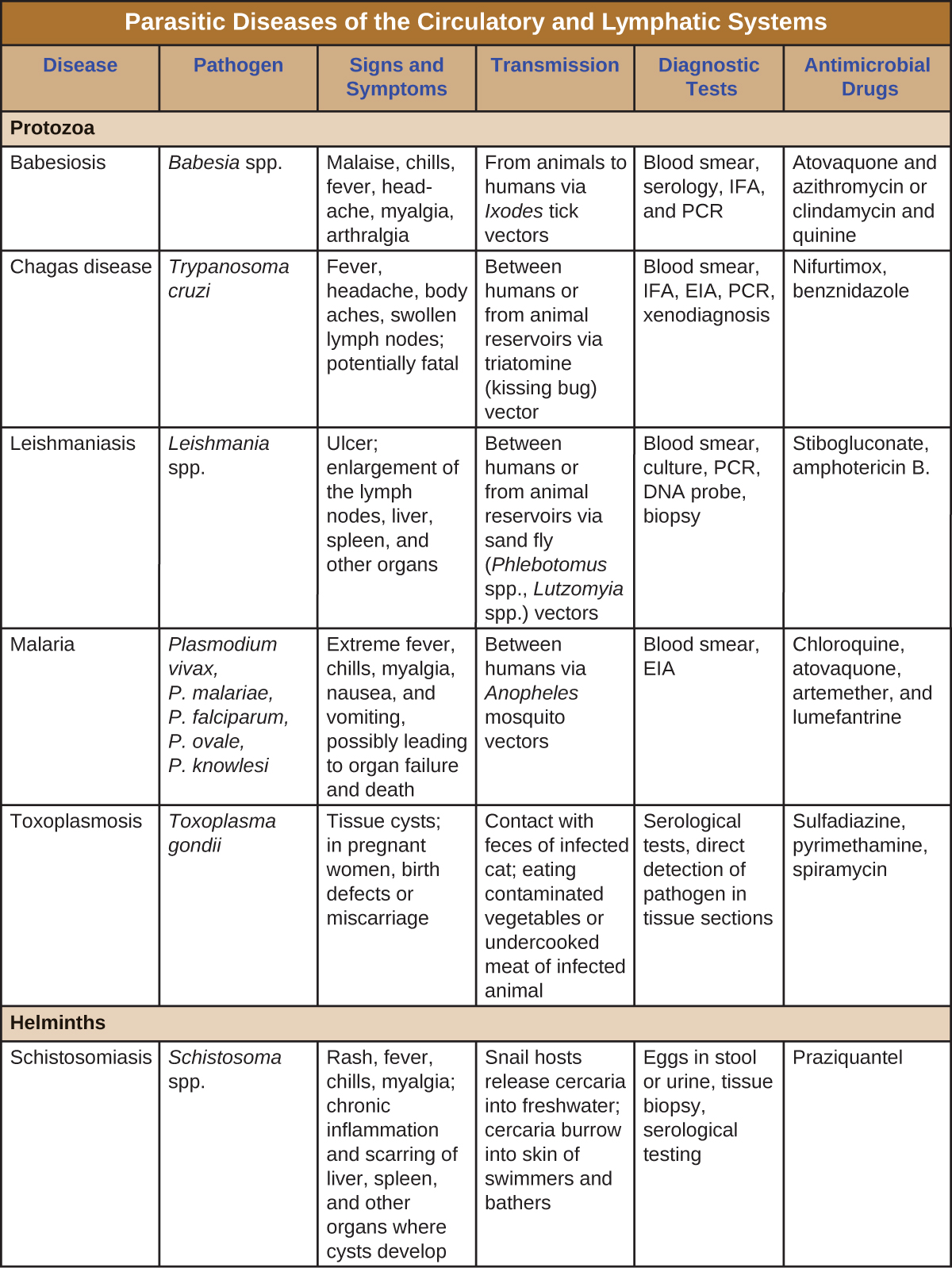 Anyone who has exposure to the virus should seek medical help immediately, without waiting for symptoms.
Anyone who has exposure to the virus should seek medical help immediately, without waiting for symptoms.
Prodrome
During prodrome, early, flu-like symptoms occur, including:
- a fever of 100.4°F (38°C) or above
- headache
- anxiety
- feeling generally unwell
- sore throat and a cough
- nausea and vomiting
- discomfort at the site of the bite
Acute neurologic period
During this stage, neurologic symptoms develop, including:
- confusion and aggression
- partial paralysis
- involuntary muscle twitching
- rigid neck muscles
- convulsions
- hyperventilation and difficulty breathing
- hypersalivation, or producing a lot of saliva
- frothing at the mouth
- fear of water, or hydrophobia
- hallucinations, nightmares, and insomnia
- priapism, or permanent erection, in males
- photophobia, or a fear of light
Toward the end of this phase, breathing becomes rapid and inconsistent.
Coma and death
A person may enter a coma, and most people then die within 3 days. During the coma stage, even with supportive therapy, virtually no person survives rabies.
Why does rabies cause a fear of water?
People used to call rabies hydrophobia because it appears to cause a fear of water. The reason is that the infection causes intense spasms in the throat when a person tries to swallow. Even the thought of swallowing water can cause spasms, making it appear that the individual is afraid of water.
If doctors are not certain that an individual received a bite from an animal infected with rabies, they typically must exclude other conditions first.
Healthcare professionals may perform multiple tests without concluding the individual has rabies. Laboratory tests may show antibodies, but these may not appear until later in the development of the disease. Doctors could potentially isolate the virus from a person’s saliva or through a skin biopsy. However, by the time they confirm a diagnosis, it is often too late to act.
However, by the time they confirm a diagnosis, it is often too late to act.
For this reason, the individual usually starts a course of prophylactic treatment immediately without waiting for a confirmed diagnosis.
If a person develops symptoms of viral encephalitis following an animal bite, doctors should treat them as if they may have rabies.
If a person has a bite or scratch from an animal that may have rabies, or if the animal licks an open wound, the individual should immediately wash any bites and scratches for 15 minutes with soapy water, povidone iodine, or detergent. This might minimize the number of viral particles. They must then seek immediate medical attention.
After exposure and before symptoms begin, a series of shots can treat potential rabies infections. Because doctors do not usually know whether the animal had rabies, it is safer to assume that they do and begin vaccination.
A small number of people have survived rabies, but most cases are fatal once symptoms develop, and there is no effective treatment at this stage.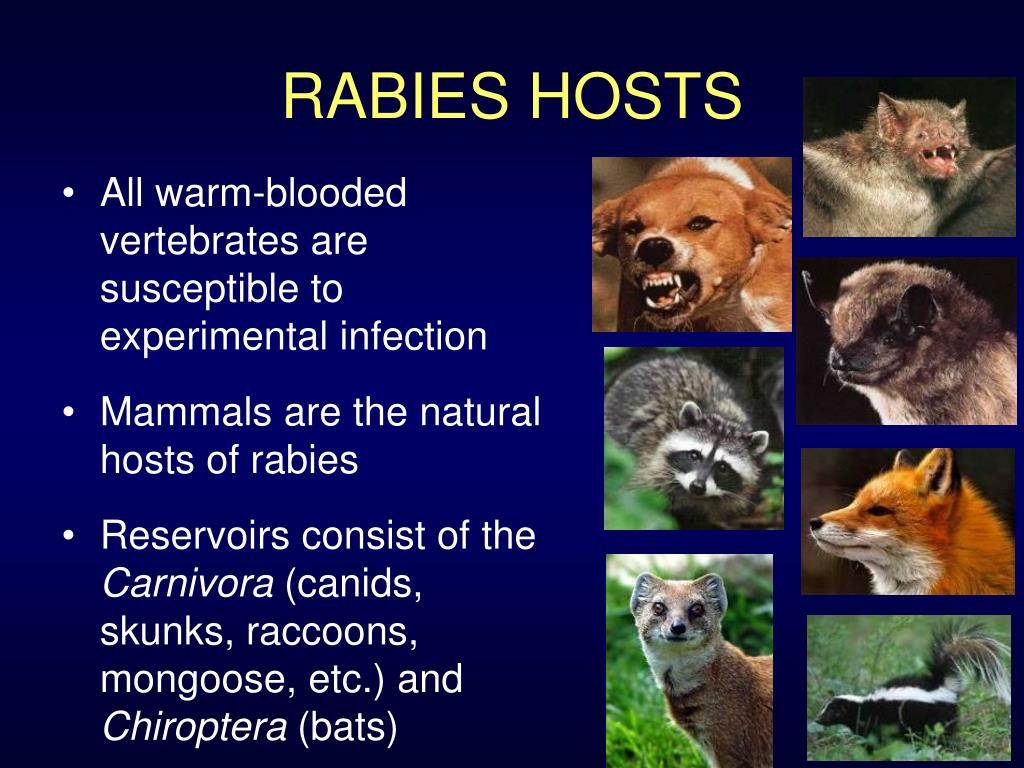 Instead, healthcare professionals will usually try and make a person with symptoms as comfortable as possible. These individuals may also need breathing assistance.
Instead, healthcare professionals will usually try and make a person with symptoms as comfortable as possible. These individuals may also need breathing assistance.
Rabies vaccine
Doctors do not offer the rabies vaccine routinely. Instead, they reserve it for those at high risk of rabies exposure, such as laboratory staff working with the virus that causes the disease, veterinarians, and people likely to receive animal bites. These individuals may receive regular vaccinations.
Other people may receive the vaccine following exposure to the virus after an animal bite. This is called postexposure prophylaxis.
Rabies vaccine contains an inactivated or a harmless version of the rabies virus, so it cannot cause the disease. It triggers the immune response to produce antibodies, which remain in the body and help protect against future rabies infections.
Doctors administer the rabies vaccine into the upper arm. Preexposure protection requires three doses of rabies vaccine across 28 days.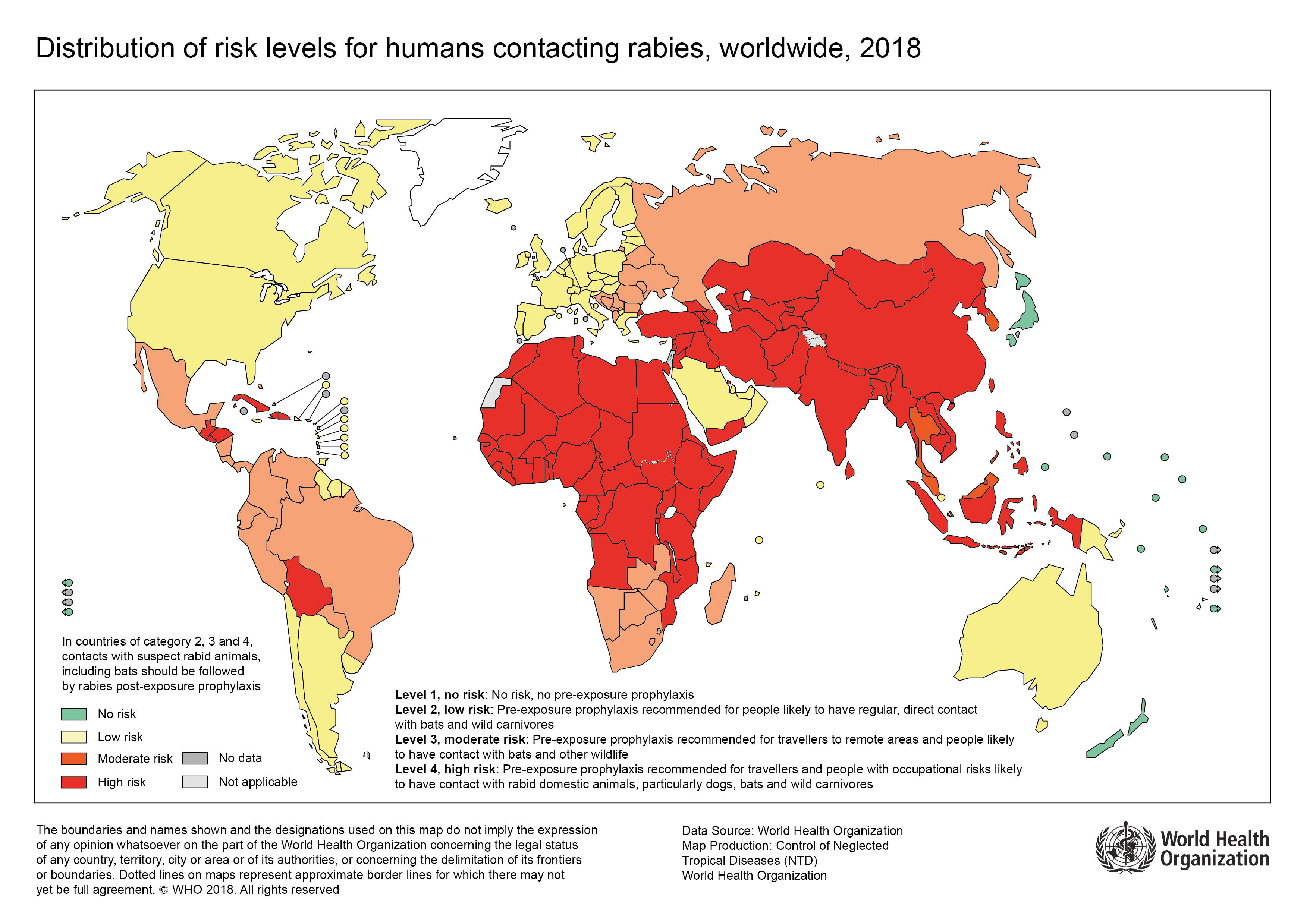
For post-exposure protection, previously unvaccinated people need four doses of the rabies vaccine, plus rabies immune globulin (RIG). Doctors administer RIG as soon as possible, close to the bite wound, to prevent the virus from causing infection in the individual. According to the World Health Organization (WHO), there are various ways of achieving this depending on the scheduling and frequency of vaccines.
Rabies is a serious disease, but individuals and governments can take steps to prevent infections.
Strategies include:
- regular rabies vaccinations for pets and domestic animals
- bans or restrictions on the import of animals from certain countries
- widespread vaccinations of humans in some areas
- educational information and awareness
- enhanced access to medical care to people who receive bites
In rural Canada and the U.S., agencies have dropped bait containing an oral vaccine to reduce the number of wild animals with rabies.
Individual precautions
Individuals should follow some safety rules to reduce the chance of contracting rabies.
- Vaccinate pets: Find out how often to vaccinate cats, dogs, ferrets, and other domestic or farm animals, and keep the vaccinations up to date.
- Protect small pets: Some pets cannot have vaccinations, so their owners must prevent contact with wild animals.
- Keep pets confined: Owners should confine pets safely while at home or supervise them.
- Report strays to local authorities: Contact local animal control officials or police departments regarding stray animals.
- Do not approach wild animals: Animals with rabies are likely to be less cautious than usual and may approach people.
- Keep bats out of the home: Seal houses to prevent bats from nesting and call an expert to remove any bats present.
In the U.S., vaccinations can control rabies in domestic dogs. Nevertheless, between 30,000 and 60,000 people seek rabies postexposure prophylaxis every year, following contact with suspect animals.
Nevertheless, between 30,000 and 60,000 people seek rabies postexposure prophylaxis every year, following contact with suspect animals.
People report between 60 and 70 dogs and around 250 cats as rabid each year in the U.S. Most of these have not been vaccinated and encountered the virus through wild animals, such as bats.
The prevalence of rabies varies widely in different countries. In nations without a feral dog population, the rates are significantly lower.
Rabies is present in 150 countries and all continents except Antarctica and the Arctic. The disease is most common in Africa and Asia, with India having the highest number of cases.
In recent years, the prevalence of rabies in South America and the Caribbean has fallen significantly due to rabies control programs. Official figures show that there were 250 cases in 1990, but by 2010, there were fewer than 10.
Anyone traveling to an area where rabies is prevalent or participating in activities where they are likely to come into contact with wild animals, such as caving or camping, should ask their doctor about vaccinations.
Rabies is a deadly virus that infected animals spread through their saliva. It causes flu-like symptoms initially, which progress into fever, muscle spasms, coma, and eventually, death.
Although there is no effective treatment once symptoms appear, rabies vaccines are usually successful in preventing infections. However, people must seek treatment immediately and not wait for any symptoms.
Individuals at high risk of rabies infections, such as veterinarians, should have preexposure vaccinations. Anyone who has a bite from a potentially infected animal should receive immediate medical attention and post-exposure vaccinations. They may also require fast-acting RIG if they have not already had the vaccine for the virus.
Rabies Prevention
Visually Impaired Version
Rabies is an infectious disease of viral etiology, characterized by damage to the central nervous system with a fatal outcome .
Infection with rabies occurs when a sick animal bites, scratches or saliva of the skin and visible mucous membranes. In the latter case, the virus enters the body through abrasions and scratches. The most dangerous damage to the face, neck and hands.
In the latter case, the virus enters the body through abrasions and scratches. The most dangerous damage to the face, neck and hands.
In humans, the incubation period (the time from the moment of infection until the first signs appear) usually lasts from 10 days to 2 months. The incubation period depends on the location of the bite (the closer to the head, the shorter). The first signs of the disease almost always appear as itching, pain at the site of the bite, and pain along the nerve pathways closest to the site of the bite. After 1-3 days, the stage of the developed disease begins, characterized by attacks of hydrophobia (hydrophobia): painful convulsive contraction of the muscles of the pharynx and larynx when trying to drink and even at the sounds of pouring water; the same phenomena arise from a breath of air (aerophobia), noise (acousticophobia), bright light (photophobia). In the future, the symptoms of arousal increase, death occurs from paralysis of the respiratory muscles or the vasomotor center.
Republic of Tatarstan – natural focus of rabies. The main source of the rabies virus is wild animals, primarily foxes, wolves, as well as dogs and cats. The penetration of predators into settlements leads to the infection of farm and domestic animals with rabies, which in turn can serve as a source of rabies infection for humans. However, human contact is also possible directly with wild animals, for example, during hunting or when predators run into private farmsteads in the countryside.
Manifestations of rabies in animals. Animal disease can manifest itself in 2 forms – violent or quiet (paralytic).
In the violent form of the disease, the dog can violently rush at others, run without looking at the road, bark hoarsely, gnaw on surrounding objects.
With rabies in the silent form, the dog may run away from the house, caress the owner, and then, as if by accident, bite him. Patient dog is depressed, climbs into a dark corner, does not respond to the call of the owner, she develops strabismus, her hind legs fail.
Cat rampage is very dangerous. The animal can jump on people’s heads, gnaw, bite and scratch surrounding objects, people and animals. Or climb into the basement, under the furniture and bite when pulling out.
Having become ill with rabies, the fox loses his sense of fear, starts running into settlements, climbing into buildings, biting cattle, flirting with dogs, rushing and biting them. He goes out onto the road, the highway, not paying attention to people. When approaching it, it always rushes at a person.
Rabid wolves, very aggressive, pounce on the victim, in spite of everything, inflict multiple deep bites in the neck and head.
Rabid cows may appear choked on food (difficulty swallowing, frightened appearance, jaw drop). With severe forms of the disease, animals roar, refuse to eat, yawn, throw themselves at walls, at people and animals. Such manifestations are also characteristic of goats and sheep with rabies.
Almost all sick animals have salivation, however, there is no fear of water.
Prevention of rabies is based on the regulation of domestic and working dogs and the vaccination of people bitten by animals.
Animals must be registered with a veterinary clinic (station) and vaccinated against rabies annually.
Walking dogs for walks must be carried out on a short leash, and dogs of fighting breeds or large ones must be muzzled. Animals should be protected from contact with stray animals. Stray dogs and cats pose a great danger and are subject to capture.
Pet owners are also required to immediately deliver dogs, cats and other pets that have caused harm to citizens to a veterinary clinic for examination and veterinary supervision by specialists within 10 days, after the end of the observation, receive a certificate of animal health. The most important measure for the prevention of rabies is the timely application for medical assistance in case of injuries (bites, scratches or saliva) by animals and the fulfillment of the prescriptions of the polyclinic doctor in full.
In case of any bite, scratching and licking by animals, it is necessary to immediately and thoroughly wash the affected skin area, lathering it until a thick soapy foam forms, treat it with antiseptic and urgently seek medical help from a surgeon or a trauma center.
RABIES IS A TERRIBLE INCURABLE DISEASE, BUT IMMUNIZATION CAN PROTECT AGAINST IT. IF YOU HAVE BEEN SUFFERED FROM AN ANIMALS, DO NOT PUT OFF SEEING YOUR DOCTOR, DO NOT REFUSE IMCCINATIONS, BECAUSE TIMELY RECEIVED ANTI-RABIC VACATIONS ARE THE ONLY EFFECTIVE MEDICINE WITH KEEP HEALTH!
Information on the prevention of infectious diseases can be found on the website http://16.rospotrebnadzor.ru/
and epidemiology in the Republic of Tatarstan (Tatarstan)”
Prevention of rabies in humans
09/17/2018
Rabies from the word “demon”; other names: rabies (lat. rabies), obsolete – hydrophobia, rabies) – an infectious disease caused by the rabies virus Rabies virus, included in the genus Lyssavirus of the Rhabdoviridae family.
rabies), obsolete – hydrophobia, rabies) – an infectious disease caused by the rabies virus Rabies virus, included in the genus Lyssavirus of the Rhabdoviridae family.
The rabies virus causes specific encephalitis (inflammation of the brain) in animals and humans. It is transmitted with saliva when bitten by sick animals.
History.
People have probably known rabies for over 500 years. The evidence of the Spanish conquistadors of 1514 describing this disease has been preserved. In July 1885, Louis Pasteur successfully developed a rabies vaccine. Currently, it is usually used in combination with anti-rabies serum or anti-rabies immunoglobulin. The injection is made deep into the wound and into the soft tissues around it. The effectiveness of the vaccine is directly related to the time of treatment after a bite. The sooner a person seeks help, the greater the chance of a positive outcome. Urgent vaccination after exposure to the virus usually prevents the development of symptoms and cures the person. Left untreated, inevitably leads to death.
Left untreated, inevitably leads to death.
Epidemiology
In nature, many animal species support the persistence and spread of the rabies virus.
There is a natural type of rabies, the foci of which are formed by wild animals (wolf, fox, raccoon dog, jackal, arctic fox, skunk, mongoose, bats), and urban type of rabies (dogs, cats, farm animals). Domestic animals become infected with rabies after contact with sick wild animals.
The specific behavior of cats exacerbates the extremely aggressive behavior of the majority of cats with rabies. In some cats, rabies occurs in a silent (paralytic) form, when a sick animal climbs into distant places (basement, under a sofa) and remains there until death, but when you try to get it, it still attacks a person. The greatest probability of infection from foxes and stray dogs living outside the city is in the spring and summer. There are cases when the causative agent of rabies is transmitted through a bite from person to person. Although the probability of such a case is extremely small.
Although the probability of such a case is extremely small.
According to WHO, 55,000 people die of rabies every year, with Asia and Africa remaining the most vulnerable.
Clinical picture.
The incubation period ranges from 10 days to 3-4 (but more often 1-3) months (in some cases up to one year), with an average of 77 days in immunized people and 54 days in non-immunized people. The likelihood of infection depends on the circumstances (for example, if a rabid animal bit a person through clothing, or if the bite caused severe bleeding, the likelihood of infection will be less). The place of the bite is also important – the most dangerous in terms of infection are the head, hands, genitals (places richest in nerve endings). But if the disease has already developed, it always proceeds in the same way.
Periods of illness.
The disease has three periods:
Prodromal (precursor period)
Lasts 1-3 days. Accompanied by an increase in temperature to 37.2-37.3 ° C, depression, poor sleep, insomnia, anxiety of the patient. Pain at the bite site is felt, even if the wound has healed for a long time.
Accompanied by an increase in temperature to 37.2-37.3 ° C, depression, poor sleep, insomnia, anxiety of the patient. Pain at the bite site is felt, even if the wound has healed for a long time.
Hot stage (hydrophobia)
Lasts 1-4 days. It is expressed in a sharply increased sensitivity to the slightest irritation of the sense organs: bright light, various sounds, noise cause cramps in the muscles of the limbs. Hydrophobia, aerophobia cause increased anxiety of the brain. Patients become aggressive, violent, hallucinations, delirium, a sense of fear appear.
Period of paralysis (stage of “ominous calm”)
There comes paralysis of the eye muscles, lower extremities. Severe paralytic respiratory disorders cause death. The total duration of the disease is 5-8 days, occasionally 10-12 days.
Diagnostics.
Of great importance is the presence of a bite or contact with the saliva of rabid animals on damaged skin.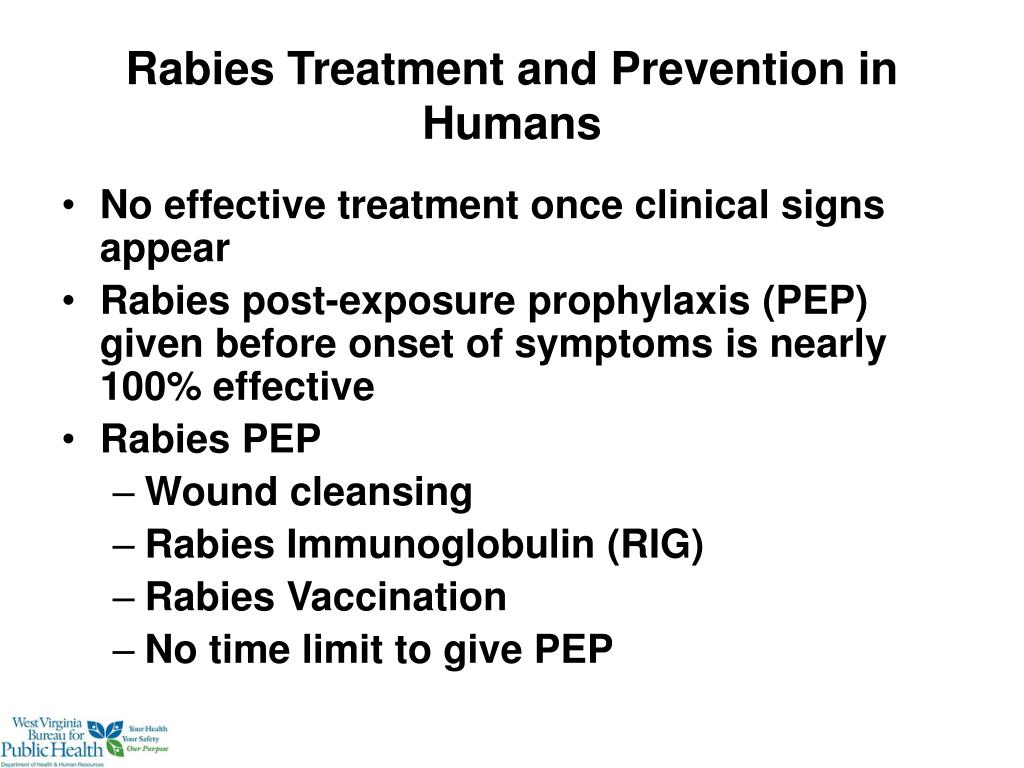 One of the most important signs of a human disease is rabies with symptoms of spasm of the pharyngeal muscles only at the sight of water and food, which makes it impossible to drink even a glass of water. No less indicative symptom aerophobia – muscle cramps that occur at the slightest movement of air. Increased salivation is also characteristic, in some patients a thin stream of saliva constantly flows from the corner of the mouth.
One of the most important signs of a human disease is rabies with symptoms of spasm of the pharyngeal muscles only at the sight of water and food, which makes it impossible to drink even a glass of water. No less indicative symptom aerophobia – muscle cramps that occur at the slightest movement of air. Increased salivation is also characteristic, in some patients a thin stream of saliva constantly flows from the corner of the mouth.
Prevention.
Prevention of rabies consists in the fight against rabies among animals: vaccination (domestic, stray and wild animals), quarantine, etc. People bitten by rabid or unknown animals should be treated locally immediately or as soon as possible after a bite or injury; the wound is washed abundantly with soap and water and treated with 40-70 degree alcohol or iodine solution, if indicated, enter anti-rabies immunoglobulin deep into the wound and into the soft tissues around it, after local treatment of the wound, specific treatment is immediately carried out, which consists in therapeutic and prophylactic immunization with the anti-rabies vaccine.
The vaccines currently in use are typically given 6 times: injections are given on the day of presentation (day 0), and then on days 3, 7, 14, 30, and 90. If it was possible to establish observation of the bitten animal, and within 10 days after the bite it remained healthy, then further injections are stopped. During vaccination and within 6 months after the last vaccination, the use of alcohol is prohibited. During the vaccination period, it is also necessary to limit the consumption of foods that can cause an allergic reaction in the patient.
You should immediately go to the nearest emergency room , as the success of rabies vaccination is highly dependent on how quickly treatment is started. It is advisable to inform the doctor at the emergency room of the following information – a description of the animal, its appearance and behavior, the presence of a collar, the circumstances of the bite. Then you should carry out a course of vaccinations prescribed by a doctor.
At the time of vaccination and 6 months after it, you must refrain from drinking alcohol. In addition, during the course of vaccination against rabies, overwork, hypothermia and overheating are prohibited. Rabies is a deadly disease , it cannot be cured, but in case of a bite by a sick animal, the disease can be prevented by a timely course of therapeutic and prophylactic vaccination. The effectiveness of vaccination is directly dependent on the time to seek help after a bite.
In order to prevent infection with rabies, it is recommended that hunters receive a course of prophylactic vaccinations against rabies, refrain from skinning and butchering animal carcasses until the results of the rabies examination of slaughtered animals from the veterinary laboratory are received. Do not allow unvaccinated dogs to hunt wild animals. In order to prevent rabies, it is necessary to carry out annual preventive vaccination against rabies of dogs, regardless of their affiliation, and, if necessary, mice and cats.
Treatment.
In the event of clinical signs of rabies, there are no effective treatments. We have to limit ourselves to purely symptomatic means to alleviate the painful condition. Motor excitation is removed with sedatives (sedatives), convulsions are eliminated with curare-like drugs. Respiratory disorders are compensated by tracheotomy and connecting the patient to an artificial respiration apparatus.
Russia.
The Federal Service for Veterinary and Phytosanitary Surveillance presented information on the epizootic situation for rabies in January 2015. More than 200 outbreaks of rabies were detected in the regions of Russia during this period. The disease is more common in domestic dogs and cats.
Since the beginning of the year, 204 cases of rabies in animals have been recorded in the country. The most dangerous situation is observed in the Republic of Tatarstan – 30 outbreaks of the disease were detected there in a month.


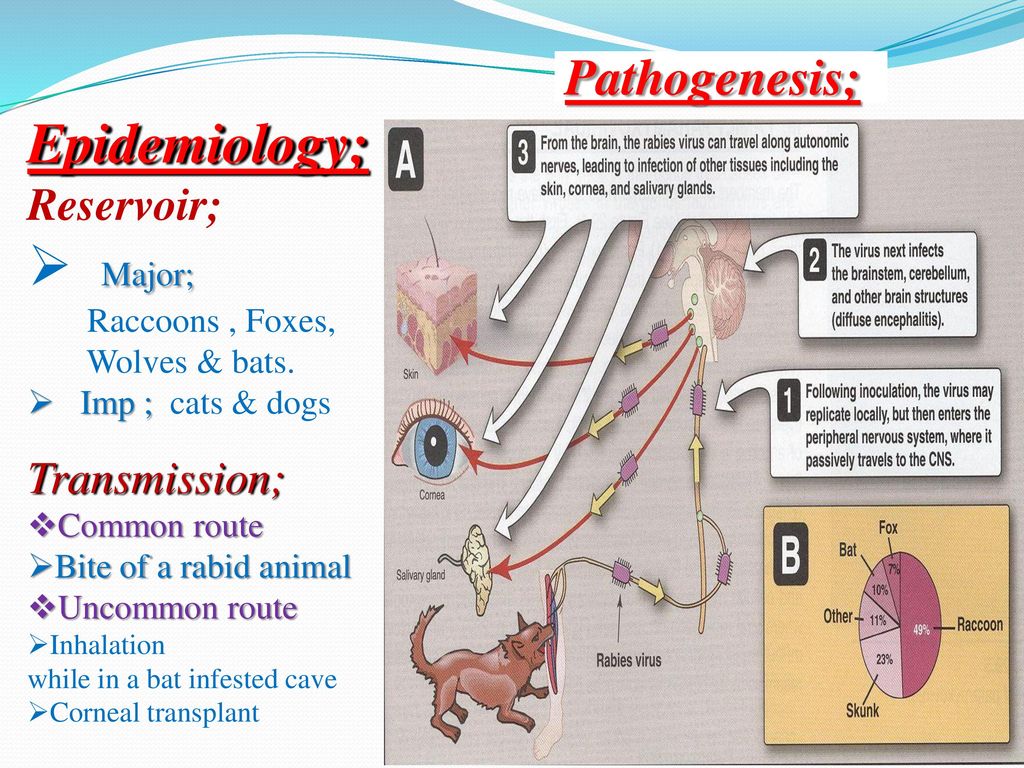 Keep pets away from strays, too.
Keep pets away from strays, too.
